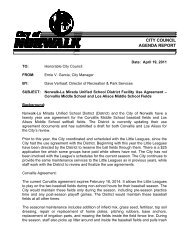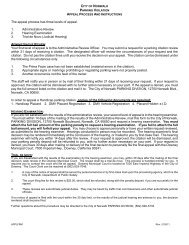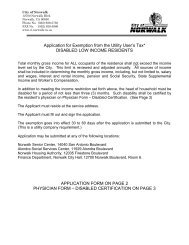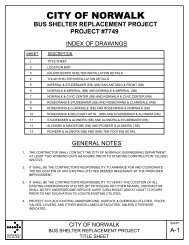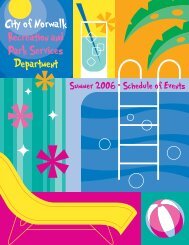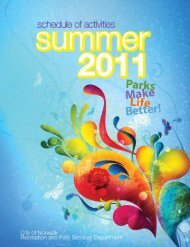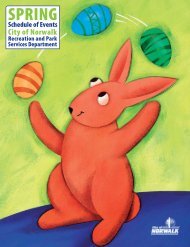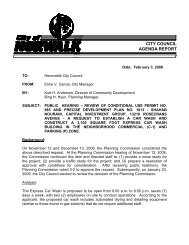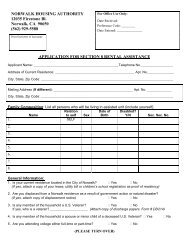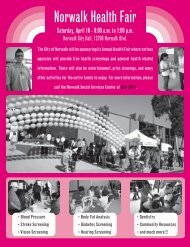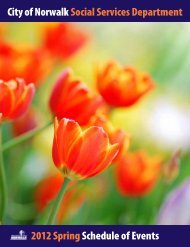serve residents Norwalk's first e-waste collection ... - City of Norwalk
serve residents Norwalk's first e-waste collection ... - City of Norwalk
serve residents Norwalk's first e-waste collection ... - City of Norwalk
Create successful ePaper yourself
Turn your PDF publications into a flip-book with our unique Google optimized e-Paper software.
A Quarterly Newsletter Of<br />
<strong>City</strong> <strong>of</strong> <strong>Norwalk</strong><br />
562-929-5700<br />
www.ci.norwalk.ca.us<br />
Spring 2006<br />
®<br />
<strong>Norwalk</strong>’s <strong>first</strong> e-<strong>waste</strong> <strong>collection</strong><br />
event set for Earth Day<br />
On April 22, Americans will be celebrating<br />
the planet. What will we be doing in<br />
<strong>Norwalk</strong> to make our planet a better<br />
place? We’ll be recycling electronics at<br />
<strong>Norwalk</strong>’s <strong>first</strong>-ever Electronic Waste<br />
Collection Event. This event is free to<br />
all <strong>Norwalk</strong> <strong>residents</strong> and businesses!<br />
Our e-<strong>waste</strong> (that’s “electronic<br />
<strong>waste</strong>”) <strong>collection</strong> will be held on<br />
Saturday, April 22 from 8 a.m. to 2 p.m.<br />
We’ll be accepting e-<strong>waste</strong> at two locations:<br />
the <strong>City</strong> Hall Parking Lot (12700<br />
<strong>Norwalk</strong> Boulevard) and the Social<br />
Services Center (11929 Alondra<br />
Boulevard).<br />
Here are the types <strong>of</strong> items that you<br />
can bring to the event:<br />
• Computer monitors<br />
• Television sets<br />
• TV/VCR combos<br />
• VCRs<br />
• Stereo Equipment<br />
• Computers<br />
• CPUs<br />
• Mice<br />
• Keyboards<br />
• Printers<br />
• Fax machines<br />
• Cell phones<br />
• Scanners, or any other<br />
computer peripheral<br />
El 22 de abril, Día del planeta Tierra, la<br />
ciudad de <strong>Norwalk</strong> llevará a cabo por<br />
primera vez el evento de Colección de<br />
Desperdicios Electrónicos. Este evento<br />
es gratuito para todos los residentes y<br />
negocios de <strong>Norwalk</strong>.<br />
Nuestra colección de desperdicios<br />
electrónicos se llevará a cabo el sábado<br />
22 de abril de 8 a.m. a 2 p.m. Estaremos<br />
aceptando este tipo de desperdicios en<br />
dos lugares: Estacionamiento de la<br />
Municipalidad (12700 <strong>Norwalk</strong><br />
Boulevard) y el Centro de Servicios<br />
Sociales (11929 Alondra Boulevard).<br />
Usted podra traer los siguientes<br />
artículos:<br />
• Monitores de computadoras<br />
• Televisiones<br />
• Combinaciones de TV/VHS<br />
• Equipos de VHS<br />
• Equipos de sonido de estéreo<br />
• Computadoras<br />
• Ratones de computadoras<br />
• Teclados<br />
• Impresoras<br />
• Máquinas de fax<br />
• Teléfonos celulares<br />
• Copiadoras, o cualquier otro<br />
artículo de computadora<br />
Use your cans wisely! Free Roundups<br />
In <strong>Norwalk</strong> you have three cans—one for<br />
recycling, one for green<strong>waste</strong>, and one<br />
for trash. We hope that you are capturing<br />
all <strong>of</strong> your recyclables and green<strong>waste</strong>.<br />
We hate to see that reusable material end<br />
up in the trash! Here’s what you need to<br />
know to recycle and compost all you can!<br />
Blue Container — Recyclables<br />
Place these items into your blue recycling<br />
can:<br />
• Aerosol Cans (empty only)<br />
• Aluminum and Tin Cans<br />
• Aluminum Foil<br />
• Cardboard<br />
• Cereal Boxes (without liners)<br />
• Computer Paper (white and colored)<br />
• Egg Cartons (cardboard only)<br />
• Foam Cups and Plates<br />
• Glass Bottles and Jars (lids <strong>of</strong>f)<br />
• Juice Cartons<br />
• Junk Mail and Brochures<br />
• Laundry Bottles<br />
• Magazines<br />
• Milk Cartons<br />
• Newspaper<br />
En <strong>Norwalk</strong> hay tres botes de basura—<br />
uno para el reciclaje, otro para la basura<br />
del jardín y otro para la basura en general.<br />
Coloque los siguientes artículos en el<br />
bote azul de reciclaje:<br />
• Latas para aerosol (solo las vacías)<br />
• Latas de aluminio y de hojalata<br />
• Papel aluminio<br />
• Carton<br />
• Cajas de cereal (quíteles la bolsa de<br />
adentro)<br />
• Papel de computadora (blanco y de<br />
color)<br />
• Envase de huevos (solo el carton)<br />
• Plastic Bags<br />
• Plastic Bottles and Containers<br />
• Plastic Milk Jugs<br />
• Phone Books<br />
• Wrapping Paper<br />
Green Container — Green<strong>waste</strong><br />
Green<strong>waste</strong> is defined as only what grows<br />
in the yard and garden. Place loose green<strong>waste</strong><br />
from your yard and garden into<br />
your green can:<br />
• Grass and Leaves (loose, not bagged)<br />
• Prunings and Weeds<br />
• Twigs and Small Branches (4 inches<br />
or less in diameter and 2 feet or less<br />
in length)<br />
• Vegetation (from the yard)<br />
If you have a large quantity <strong>of</strong> twigs<br />
and small branches, you may bundle them<br />
and request a “bulky item pickup.” You<br />
must call at least 24 hours in advance <strong>of</strong><br />
your regular <strong>collection</strong> day to receive this<br />
service.<br />
Please, DO NOT place any green<strong>waste</strong><br />
into plastic bags. Green<strong>waste</strong><br />
should be loose when placed into the can!<br />
• Tazas y platos descartables<br />
• Botellas y frascos de vidrio (quíteles<br />
las tapas)<br />
• Recipientes de cartón para jugos<br />
• Folletos y correo comercial<br />
• Botes de detergentes<br />
• Revistas<br />
• Recipientes de cartón para la leche<br />
• Periódicos<br />
• Bolsas de plástico<br />
• Botellas y envases de plástico<br />
• Recipientes de plástico para la leche<br />
• Directorios telefónicos<br />
(Continúa en Pág. 4)<br />
<strong>serve</strong> <strong>residents</strong><br />
Los Angeles County <strong>residents</strong> have the<br />
opportunity to safely dispose <strong>of</strong> household<br />
hazardous <strong>waste</strong> and e-<strong>waste</strong> free<br />
<strong>of</strong> charge at Countywide Household<br />
Hazardous Waste and E-Waste Roundups.<br />
The next free Roundup that will take<br />
place near <strong>Norwalk</strong> is scheduled for<br />
Saturday, May 13, from 9 a.m. to 3 p.m.,<br />
at La Mirada Regional Park, Tennis<br />
Court/Swimming Pool Parking Lot, on<br />
Adelfa Drive.<br />
Many common household products<br />
pose a hazard to the environment if disposed<br />
<strong>of</strong> improperly. Materials such as<br />
used motor oil, paint, turpentine, acid or<br />
lye-based cleaners, household and car<br />
batteries, pesticides, and garden herbicides<br />
can damage the environment if<br />
tossed in the trash or poured down a sink<br />
or storm drain.<br />
Household e-<strong>waste</strong> is consumer electronic<br />
equipment near the end <strong>of</strong> its useful<br />
life, such as computer monitors and<br />
televisions which cannot be disposed <strong>of</strong><br />
(Continued on Page 4)<br />
PRSRT STD<br />
US POSTAGE<br />
PAID<br />
NORWALK, CA<br />
PERMIT NO. 162<br />
POSTAL PATRON<br />
NORWALK, CA 90650
Page 2 Spring 2006<br />
10 Tips<br />
for a better Earth Day<br />
and a better year for the Earth<br />
On April 22, 1970, school children, college students,<br />
parents, business people, elected <strong>of</strong>ficials,<br />
and more came together in the largest demonstration<br />
ever held in America—Earth Day. The brainchild<br />
<strong>of</strong> Gaylord Nelson, a U.S. Senator from<br />
Wisconsin, Earth Day was planned as a “teach-in” about<br />
the environment for members <strong>of</strong> the U.S. Congress.<br />
However, word spread. By Earth Day, 20 million<br />
Americans joined together in our nation’s capitol, at city<br />
halls and county courthouses, and in their own neighborhoods<br />
to say, “Let’s do something to clean up pollution!”<br />
Earth Day didn’t stop on April 22, 1970. In the<br />
years that followed, government, business, and private<br />
citizens worked together to clean up our air, land, and<br />
water. What we learned on Earth Day is that one day<br />
isn’t enough—it takes a long-term commitment to make<br />
our world a more livable place.<br />
Here are some <strong>of</strong> the ways you can make it a better<br />
year:<br />
1. Know more about what is happening in our community.<br />
Read the paper. Listen to local news. Use the<br />
Internet to find local events.<br />
Attend public meetings.<br />
Whenever you get the<br />
chance to vote, do it.<br />
2. Take walks and get to know<br />
our community. While<br />
you’re out, pick up litter<br />
that you see. If your dog<br />
joins you, be sure to pick up<br />
after your canine companion.<br />
3. Volunteer outdoors. You<br />
QUOTES<br />
‘‘<br />
Earth Day worked because <strong>of</strong> the spontaneous response<br />
at the grassroots level. We had neither the time nor<br />
resources to organize 20 million demonstrators and<br />
the thousands <strong>of</strong> schools and local communities that<br />
participated. That was the remarkable thing about<br />
Earth Day. It organized itself.<br />
Gaylord Nelson, 1916-2005<br />
might mow the lawn for an<br />
elderly neighbor. You might<br />
pick up litter at a park or<br />
playground.<br />
4. Reduce, reuse, and recycle!<br />
Eliminate <strong>waste</strong> by buying<br />
less stuff that you don’t<br />
really need. Avoid excessively<br />
packaged items. Say<br />
“no thanks” to store bags<br />
whenever possible. Carry<br />
your own refillable c<strong>of</strong>fee<br />
mug. Use your stuff until it wears out. Buy used<br />
items. Sell or donate usable stuff that you no longer<br />
need. Know what, where, and how to recycle.<br />
5. Waste less food. Plan meals so that less moldy or<br />
spoiled food has to be thrown away. Finish the leftovers.<br />
6. Make wise choices when you buy electronics and<br />
take good care <strong>of</strong> the equipment you have. Update<br />
s<strong>of</strong>tware and services, upgrade memory, or add<br />
accessories, as needed. Look for the “Energy Star”<br />
certification.<br />
7. Become a greener gardener. Replace lawn areas by<br />
planting more trees, native or low-water-using plant<br />
materials, and ground covers. Reduce your use <strong>of</strong><br />
chemicals, and thus <strong>of</strong> potentially hazardous <strong>waste</strong>,<br />
by learning to use “Integrated Pest Management” to<br />
control weeds and bugs. Mulch and compost.<br />
8. Learn more about the world in which we live. Take<br />
a close look at the non-fiction videos at the library.<br />
Read a book or magazine about science or nature,<br />
plants or animals, politics or policy.<br />
9. Touch the future—teach a child. Author Amanda<br />
10 consejos para celebrar un mejor Día de la Tierra y un mejor año para la Tierra<br />
El 22 de abril de 1970, 20 millones de americanos se<br />
reunieron en la capital de la nación, en las alcaldías y en<br />
las cortes de los condados, y hasta en sus propios vecindarios<br />
para afirmar, “¡Hagamos algo para limpiar la contaminación!”<br />
En los años posteriores a ese evento, los<br />
gobiernos, los negocios y organizaciones privadas de<br />
ciudadanos trabajaron unidos para limpiar el aire que<br />
respiramos, la tierra donde vivimos y el agua que<br />
usamos. Lo que aprendimos el Día de la Tierra es que un<br />
solo día no es suficiente –toma mucho tiempo hacer de<br />
nuestro mundo un lugar más habitable.<br />
Aquí le <strong>of</strong>recemos algunos consejos para hacer que<br />
nuestro planeta sea más habitable este año: Involúcrese<br />
con su comunidad. Aprenda acerca de los eventos<br />
Founder <strong>of</strong> "Earth Day"<br />
locales. Asista a las juntas públicas. Salga a caminar y<br />
conozca a sus vecinos. ¡Reduzca, re-use y recicle su<br />
basura! Evite comprar cosas que en realidad no necesita.<br />
Cuando le sea posible, no ocupe las bolsas de la tienda.<br />
Compre cosas usadas. Venda o done las cosas usadas que<br />
usted ya no ocupa o necesita. Aprenda qué, dónde y<br />
cómo reciclar. Desperdicie menos comida. Tome decisiones<br />
inteligentes cuando compre aparatos electrónicos<br />
y cuide del equipo que ya posee. Reduzca el uso de<br />
químicos para el jardín aprendiendo acerca del “Manejo<br />
Integrado de Plagas” que le ayudara a controlar malas<br />
hierbas e insectos. Deje la poda de su pasto en su mismo<br />
jardín — mulch — y aprenda sobre la descomposición<br />
de las materias orgánicas — compost.<br />
REQUOTED<br />
Citas Citables<br />
El éxito del Día de la Tierra fue debido a la respuesta<br />
espontánea de “haber pasado la voz” entre sus<br />
amistades. No teníamos ni el tiempo ni los recursos<br />
para organizar a 20 millones de personas que se<br />
unieron en las demostraciones, ni a las miles de<br />
escuelas y comunidades que participaron. Eso fue lo<br />
maravilloso del Día de la Tierra. ¡Funciono solito!<br />
Lumry is writing<br />
a series <strong>of</strong> books<br />
for children in<br />
kindergarten<br />
through third<br />
grade. This<br />
series, The<br />
Adventures <strong>of</strong><br />
Riley, combines<br />
stories about<br />
Riley and his family with facts and photos about the<br />
real places featured in each story.<br />
10. Don’t keep your Earth Day commitments a secret.<br />
Tell your friends and family about your new habits.<br />
What is Integrated<br />
Pest Management?<br />
Integrated pest management (IPM) starts with knowing<br />
your plants and their pests. This means regular<br />
monitoring and good record-keeping to determine if<br />
and when action is needed. When pests are present in<br />
numbers that could result in damage to plants, a variety<br />
<strong>of</strong> methods are used, beginning with those that are<br />
most benign and least expensive. With IPM, chemical<br />
pesticides are a last resort.<br />
For more information, visit www.epa.gov/pesti<br />
cides/ipm/ or www.epa.gov/pesticides/food/ipm.htm.<br />
¿Qué quiere decir “Manejo<br />
Integrado de Plagas”?<br />
El manejo integrado de plagas quiere decir controlar<br />
las plagas a través de una variedad de métodos,<br />
empezando por los que son más benignos y menos<br />
costosos, dejando la opción de utilizar pesticidas<br />
químicos como última alternativa. Para más información<br />
visite la página de Internet www.epa.gov/<br />
pesticides/ipm/ o la página www.epa.gov/pesticides<br />
/food/ipm.htm.<br />
Think<br />
about it!<br />
A disposable, carry-out c<strong>of</strong>fee<br />
cup weighs about one ounce. If<br />
you drink two carry-out c<strong>of</strong>fees<br />
every day, each week, all year<br />
long, you throw away 728<br />
ounces <strong>of</strong> c<strong>of</strong>fee cups—that’s<br />
45.5 pounds <strong>of</strong> trash!<br />
¡Piénselo!<br />
Una taza desechable para su café pesa aproximadamente<br />
una onza. Usted puede reducir montones de<br />
basura con tan solo utilizar una taza que pueda<br />
volver a usar una y otra vez.
Page 3 Spring 2006<br />
We’re living in a<br />
material world<br />
What if you took all <strong>of</strong><br />
your possessions and put<br />
them into your front yard?<br />
That’s the question photographer<br />
Peter Menzel<br />
asked himself. It’s also the<br />
question which sent him<br />
to 30 different countries to<br />
meet and photograph one<br />
“average family.” The<br />
result <strong>of</strong> this search was<br />
the book, Material World:<br />
A Global Family Portrait<br />
by Peter Menzel and<br />
Charles C. Mann,<br />
which was originally<br />
published in<br />
1994.<br />
Each family<br />
portrait pictures the<br />
family outside their<br />
home with all (or<br />
almost all) <strong>of</strong> their<br />
possessions. The<br />
possessions are not<br />
stacked to the side<br />
but are displayed in<br />
such a way as to be<br />
integrally part <strong>of</strong> the portrait, as though<br />
these things are precious members <strong>of</strong> the<br />
family. The text describes the family and<br />
Vivimos en un mundo material<br />
En Material World: A Global Family Portrait por Peter Menzel y Charles C. Mann<br />
(1994), 30 familias alrededor del mundo fueron fotografiadas fuera de sus hogares con<br />
todas sus pertenencias. En Hungry Planet: What the World Eats por Peter Menzel y<br />
Faith D’Aluisio (2005), 30 familias alrededor del mundo fueron fotografiadas en sus<br />
hogares y en los supermercados con la comida que comen. Ambos libros nos hacen<br />
pensar sobre lo que tenemos, lo que necesitamos, lo que queremos, y lo que<br />
guardamos.<br />
Garden<br />
Gadgets<br />
Would you like to create better garage<br />
storage? How about some festive outdoor<br />
lighting for your garden? Want to welcome<br />
your fine, feathered friends? Get on<br />
the Internet and go to www.care2.com/<br />
channels/solutions/home/456 to find the<br />
instructions for “Five Cool Make-It-<br />
Yourself Garden Gadgets.”<br />
The web page actually <strong>of</strong>fers these<br />
six project ideas with complete instructions:<br />
• Lanterns made from glass baby food<br />
jars<br />
• Bird feeder and sanctuary using an<br />
old birdbath<br />
• Birdseed catcher made from an old<br />
doormat<br />
• Tool storage chest made from an old<br />
Decoraciones para el jardín<br />
their lifestyle. Sidebars<br />
<strong>of</strong>fer background on the<br />
countries in which they<br />
live. The differences<br />
between countries are, <strong>of</strong><br />
course, striking and at<br />
times surprising.<br />
If you enjoy Material<br />
World, take a look at the<br />
new book, Hungry Planet:<br />
What the World Eats by<br />
Peter Menzel and Faith<br />
D’Aluisio (2005). This<br />
book also pr<strong>of</strong>iles 30 families<br />
around the<br />
world. However,<br />
instead <strong>of</strong> their possessions,<br />
Hungry<br />
Planet features<br />
their diets and pictures<br />
them in the<br />
marketplaces and<br />
with their foodstuffs.<br />
Both books make<br />
you think about<br />
what we have, what<br />
we need, what we<br />
want, what we save, what we <strong>waste</strong>, and<br />
what all <strong>of</strong> this might mean to the global<br />
family.<br />
filing cabinet<br />
• Dahlia tuber holder made from plastic<br />
strawberry flats<br />
• String caddy made from a plastic<br />
detergent bottle<br />
Do you notice what these projects<br />
have in common? That’s it. They are all<br />
made from reused and found materials.<br />
Your own recycling bin or a neighborhood<br />
garage sale could become the source<br />
<strong>of</strong> the raw materials that you need for<br />
these and other projects.<br />
All <strong>of</strong> these ideas and many more<br />
are published in the book Great Garden<br />
Gadgets: Make-It-Yourself Gizmos and<br />
Projects, edited by Fern Marshall Bradley<br />
and Christine Bucks (Rodale Press, 2001).<br />
Aprenda a hacer atractivos accesorios para el jardín usando materiales reciclados o<br />
que pueda volver a utilizar consultando la página del Internet www.care2.com/chan<br />
nels/solutions/home/456. Todas las instrucciones publicadas en esa página las puede<br />
encontrar también en el libro, Great Garden Gadgets: Make-It-Yourself Gizmos and<br />
Projects, editado por Fern Marshall Bradley y Christine Bucks (Rodale Press, 2001).<br />
No Waste<br />
Like Home<br />
clean up<br />
clear out<br />
save money<br />
Reality TV viewers in Britain are watching<br />
host Penney Poyzer expose the habits <strong>of</strong><br />
some very <strong>waste</strong>ful families in “No Waste<br />
Like Home.” With a combination <strong>of</strong> shock,<br />
shame, and wit, Poyzer teaches the families<br />
to clean up, clear out, and save money in the<br />
process. Her tips focus on reducing, reusing, and recycling <strong>waste</strong>; saving<br />
energy; cleaning with non-toxic cleaners; and selecting eco-friendly products.<br />
Read Poyzer’s tips at www.bbc.co.uk/homes/tv_and_radio/nwlh_index.shtml.<br />
Nada Como los Desperdicios del Hogar<br />
En Inglaterra hay un programa de televisión, “No Waste Like Home,” donde<br />
el anfitrión Penney Poyzer presenta los hábitos de varias familias que producen<br />
mucho desperdicio. Poyzer les enseña a las familias a limpiar, arreglar<br />
y ahorrar dinero en el proceso. Para aprender más sobre las técnicas de<br />
Poyzer, consulte la página de Internet www.bbc.co.uk/homes/tv_ and_radio/<br />
nwlh_index.shtml.<br />
A flurry <strong>of</strong><br />
flip-flops<br />
Una ráfaga de sandalias<br />
Bitters Company is taking the sandal scrap from<br />
the cutting room floor <strong>of</strong> flip-flop manufacturers<br />
and turning it into floating key chains, colorful<br />
crates, barrels, and doormats.<br />
The Bitters Company’s use <strong>of</strong> flip-flop scrap<br />
is what we call “pre-consumer recycled content.”<br />
Pre-consumer <strong>waste</strong> is industrial scrap that could<br />
not be turned into the intended product. Cut ends<br />
<strong>of</strong> plastic, fabric, or paper are good examples <strong>of</strong><br />
this <strong>waste</strong>. We refer to it as “pre-consumer”<br />
because no one like you ever purchased and used<br />
this portion <strong>of</strong> the raw material. In other words, it<br />
was discarded before it got to the consumer.<br />
In addition to these pre-consumer flip-flop<br />
products, Bitters Company also makes several<br />
items from post-consumer <strong>waste</strong>, including<br />
bowls made from the steel sides <strong>of</strong> used 55-gallon<br />
drums and from old magazines. For more<br />
information, call toll-free 1-866-664-2488, e-<br />
mail info@bittersco.com, or visit the website,<br />
www.bittersco.com.<br />
La compañía Bitters ha tomado los desperdicios de los fabricantes de sandalias<br />
de dedo para convertirlos en llamativos llaveros, coloridos botes, embalajes,<br />
barriles y tapetes para las entradas de casas. Esta práctica de la compañía Bitters<br />
es lo que llamamos “contenido reciclados de pre-consumidor.” Los desperdicios<br />
“pre-consumidor” son sobrantes industriales que se desechan antes de que se<br />
utilicen para fabricar un producto para el consumidor.<br />
Además de estos productos, la compañía Bitters también fabrica otros<br />
artículos que utilizan sobrantes “post-consumidor”, entre los cuales encontramos<br />
tazones fabricados con los lados de tambores de 55 galones y con periódicos.<br />
Para mayor información favor de llamar al 1-866-664-2488, o envíe un e-mail a<br />
info@bittersco.com, o visite la página de Internet www.bittersco.com.<br />
flip-flops
Page 4 Spring 2006<br />
The rules have changed<br />
As <strong>of</strong> February 2006, California<br />
<strong>residents</strong> and small businesses<br />
must NOT dispose <strong>of</strong> universal<br />
<strong>waste</strong> with regular trash<br />
Universal <strong>waste</strong> is lower-risk hazardous<br />
<strong>waste</strong> that is generated by a large number<br />
<strong>of</strong> people in their homes or small businesses.<br />
Universal <strong>waste</strong> includes batteries<br />
in your phone or flashlight, the old cell<br />
phone you no longer need, the TV you just<br />
replaced, fluorescent tubes, and more.<br />
All universal <strong>waste</strong>s contain hazardous<br />
components. The hazardous metals or<br />
chemicals are safely contained during normal<br />
use <strong>of</strong> the item, but these same metals<br />
and chemicals become problematic and can<br />
be released if the items are broken or disposed<br />
improperly. Because <strong>of</strong> the hazards<br />
associated with disposing <strong>of</strong> universal<br />
<strong>waste</strong>s, it became illegal to mix any <strong>of</strong><br />
them with regular trash as <strong>of</strong> February 9,<br />
2006.<br />
Universal <strong>waste</strong>s include these items:<br />
• Common (household) batteries<br />
• Fluorescent tubes and bulbs<br />
• Older thermostats<br />
• Electronic devices, such as TVs, computers,<br />
printers, cell phones, VCRs,<br />
portable telephones, radios, and<br />
microwave ovens<br />
• Cathode ray tubes (the “picture tubes”<br />
in traditional televisions or computer<br />
monitors)<br />
• Mercury switches found in household<br />
appliances and automobiles<br />
• Novelties that contain mercury, including<br />
greeting cards that play music<br />
when opened and athletic shoes that<br />
light up (if made prior to 1997)<br />
• Mercury thermometers (glass thermometers<br />
with the silver liquid inside)<br />
• Non-empty aerosol cans that contain<br />
hazardous material, such as butane<br />
lighters or spray paint cans<br />
Universal <strong>waste</strong>s from <strong>Norwalk</strong> <strong>residents</strong><br />
are accepted through these programs:<br />
• Residents can drop <strong>of</strong>f universal<br />
<strong>waste</strong>s for free at the Countywide<br />
Household Hazardous Waste and E-<br />
Waste Roundups (see front page).<br />
• Residents can call Curbside Inc. to<br />
schedule an at-home pickup. This service<br />
is available to all <strong>Norwalk</strong> <strong>residents</strong><br />
by appointment for a $10 copay.<br />
For details, call 1-800-449-7587.<br />
• E-<strong>waste</strong>, including computers and televisions,<br />
will be accepted at our free<br />
drop-<strong>of</strong>f event on April 22. (See front<br />
page for details.)<br />
• E-<strong>waste</strong> items are now accepted as<br />
“bulky items” at the curb. Bulky item<br />
pickups are available to residential<br />
We want your suggestions,<br />
questions & comments!<br />
<strong>City</strong> <strong>of</strong> <strong>Norwalk</strong><br />
12700 <strong>Norwalk</strong> Blvd.<br />
<strong>Norwalk</strong>, CA 90650<br />
562-929-5700<br />
www.ci.norwalk.ca.us<br />
Funded by the <strong>City</strong> <strong>of</strong> <strong>Norwalk</strong>,<br />
Consolidated Disposal Service, CR&R,<br />
and funded by a grant from the California<br />
Integrated Waste Management Board.<br />
“Zero Waste — You Make It Happen”<br />
Copyright© 2006<br />
<strong>City</strong> <strong>of</strong> <strong>Norwalk</strong> and Eco Partners, Inc.<br />
All rights re<strong>serve</strong>d.<br />
PRINTED ON RECYCLED PAPER<br />
70% POST-CONSUMER NEWS<br />
CONTENT, USING SOY INKS<br />
customers four times each year at no<br />
charge. This service is only available<br />
by appointment. (See article on this<br />
page.)<br />
• Universal <strong>waste</strong>s, along with household<br />
hazardous (chemical) <strong>waste</strong>, are<br />
La basura universal es basura con bajo<br />
riesgo de contaminación que producen<br />
una gran cantidad de personas en sus<br />
casas y en sus negocios pequeños. Toda<br />
la basura universal contiene componentes<br />
peligrosos. Debido a los peligros<br />
asociados con el desecho de la basura<br />
universal, a partir del 9 de febrero del<br />
2006 es ilegal mezclar este tipo de<br />
basura con su basura general<br />
La basura universal incluye los<br />
siguientes artículos: baterías; tubos y<br />
focos fluorescentes; termóstatos viejos;<br />
aparatos electrónicos; monitores de computadora<br />
y televisión (conocidos como<br />
cathode ray tubes); apagadores de mercurio<br />
que se encuentran en los enseres<br />
domésticos; automóviles y artículos<br />
novedosos; termómetros de mercurio;<br />
latas de aerosol con contenidos peligrosos,<br />
tales como encendedores de gas<br />
butano y latas de aerosol con pintura.<br />
Los residentes pueden deshacerse de<br />
Electronics now collected<br />
curbside as “bulky items”<br />
Items that cannot fit in your automated<br />
garbage containers are considered “bulky<br />
items.” To help you dispose <strong>of</strong> these items<br />
properly, each residential customer is entitled<br />
to four free pickups a year with each<br />
pickup consisting <strong>of</strong> up to five bulky<br />
items.<br />
Common bulky items include:<br />
• E-<strong>waste</strong>, including computers, televisions,<br />
and related items<br />
• Mattresses<br />
• Couches<br />
• Chairs<br />
• Washers and Dryers<br />
• Desks<br />
accepted through the “Mr. Sun<br />
Program,” the neighborhood cleanup<br />
events (while in your area only).<br />
Remember—absolutely NO universal<br />
<strong>waste</strong>s can be mixed with your trash and<br />
placed into your trash can. Also, universal<br />
<strong>waste</strong>s should NOT be placed into recycling<br />
or green<strong>waste</strong> containers.<br />
esta basura universal a través de los<br />
siguientes programas:<br />
• En los eventos de Countywide<br />
Household Hazardous Waste and E-<br />
Waste Roundups (Ver Pag. 1.)<br />
• Con la empresa Curbside Inc. quien<br />
<strong>of</strong>rece servicio a domicilio para los<br />
residentes de <strong>Norwalk</strong> (Hay un cargo<br />
de $10. Para más información llame al<br />
1-800-449-7587.)<br />
• En el evento de Electronic Waste<br />
Collection del 22 de abril (Ver Pag. 1.)<br />
• Solicitando con previa cita su servicio<br />
a domicilio de artículos grandes y<br />
basura electrónica (Ver esta Pág.)<br />
• A través del programa de limpieza<br />
“Mr. Sun”, en los vecindarios<br />
Recuerde—queda absolutamente<br />
PROHIBIDO mezclar la basura universal<br />
con su basura general. Asimismo,<br />
recuerde que la basura universal NO<br />
debe de terminar ni en su bote de reciclaje,<br />
ni en el de la basura del jardín.<br />
Free battery recycling<br />
Starting April 10, <strong>Norwalk</strong> <strong>residents</strong> can dispose <strong>of</strong> their household batteries at these<br />
facilities free <strong>of</strong> charge:<br />
<strong>City</strong> Hall, 12700 <strong>Norwalk</strong> Boulevard<br />
<strong>Norwalk</strong> Arts & Sports Complex, 13000 Clarkdale Avenue<br />
Social Services Center, 11929 Alondra Boulevard<br />
Senior Center, 14040 San Antonio Drive<br />
Transportation/Public Services Facility, 12650 E. Imperial Highway<br />
Gerdes Park—Recreation Center, 14700 Gridley Road<br />
Hermosillo Park—Recreation Center, 11959 162nd Street<br />
<strong>Norwalk</strong> Park—Teen Center, 13000 Clarkdale Avenue<br />
Please remember that these containers are for household batteries only: alkaline<br />
(AA, AAA, C, D), nickel-cadmium (wet or dry), carbon zinc (non-mercury), nickel<br />
iron, nickel metal hydride, and lithium ion. No car batteries will be accepted.<br />
For more information, please contact <strong>City</strong> Hall at 562-929-5700.<br />
Los residentes de <strong>Norwalk</strong> pueden ahora reciclar las pilas del hogar en los sitios<br />
arriba mencionados (en el texto en inglés).<br />
• Tables<br />
• Microwave Ovens<br />
Bulky item pickups must be scheduled<br />
at least 24 hours prior to your scheduled<br />
trash service day. To schedule a bulky<br />
item pickup, contact your trash company:<br />
• Consolidated Disposal<br />
562-663-3400<br />
• CR&R<br />
562-944-4716<br />
Please note that apartment complexes<br />
are considered commercial accounts and<br />
will be charged a fee for bulky item service.<br />
For additional information, please<br />
contact your trash company.<br />
Los artículos que no caben en sus botes de basura se consideran “artículos grandes.”<br />
Cada cliente residencial tiene derecho a cuatro servicios a domicilio al año, cada uno<br />
consistiendo de hasta 5 artículos grandes.<br />
Para aprovechar este servicio es necesario hacer una cita por lo menos 24 horas<br />
antes del día en que le recogen la basura. Llame a su compañía de basura: Consolidated<br />
Disposal (562-663-3400) ó CR&R (562-944-4716).<br />
Por favor tome nota que los residentes de apartamentos son considerados cuentas<br />
comerciales y de usar este servicio recibirán un cargo adicional. Para más información,<br />
comuníquese con su compañía de basura.<br />
Roundups...<br />
(Continued from Page 1)<br />
in trash cans. Unfortunately, electronic<br />
<strong>waste</strong> is a growing problem although<br />
many <strong>of</strong> these products can be reused,<br />
refurbished, or recycled, including items<br />
such as VCRs, stereos, fax machines,<br />
copiers, computer keyboards and cellular<br />
telephones.<br />
Collect those unwanted household<br />
hazardous <strong>waste</strong> and e-<strong>waste</strong> items and<br />
bring them to a free Roundup. We’ll recycle<br />
what we can and properly dispose <strong>of</strong><br />
the rest. It’s easy to participate. Leave the<br />
products in their original containers,<br />
place them in a cardboard box, and drive<br />
to the Roundup site. The entire process<br />
only takes a few minutes and you never<br />
have to leave your car. No explosive or<br />
radioactive materials, tires, or <strong>waste</strong> from<br />
business will be accepted. Please do not<br />
mix chemical products together.<br />
The Free Countywide Household<br />
Hazardous Waste and E-Waste Roundups<br />
are brought to you by the County <strong>of</strong> Los<br />
Angeles and presented by the Department<br />
<strong>of</strong> Public Works and the Sanitation<br />
Districts <strong>of</strong> Los Angeles County, in cooperation<br />
with the cities <strong>of</strong> Artesia, Cerritos,<br />
La Habra Heights, La Mirada, <strong>Norwalk</strong>,<br />
Santa Fe Springs, and Whittier.<br />
For more information on household<br />
hazardous <strong>waste</strong> or upcoming Roundups,<br />
call the Los Angeles County Department<br />
<strong>of</strong> Public Works at 1-888-CLEAN-LA,<br />
the Sanitation Districts <strong>of</strong> Los Angeles<br />
County at 1-800-238-0172, or visit the<br />
website, www.lacsd.org.<br />
Attention, <strong>Norwalk</strong> <strong>residents</strong>: If you<br />
don’t want to deliver your household hazardous<br />
<strong>waste</strong> and e-<strong>waste</strong> to a Countywide<br />
Roundup, you can schedule a pickup from<br />
your home. There is a $10 co-pay for this<br />
service. However, for a limited time only,<br />
the $10 co-pay is being waived. So take<br />
advantage <strong>of</strong> this FREE service today! For<br />
details, call 1-800-449-7587.<br />
Los residentes del condado de Los<br />
Angeles pueden, sin peligro alguno,<br />
deshacerse de la basura del hogar contaminante<br />
(como substancias químicas<br />
del hogar y del jardín) y desperdicios<br />
electrónicos (artículos electrónicos) sin<br />
cargo alguno durante uno de los eventos<br />
de Countywide Household<br />
Hazardous Waste and E-Waste<br />
Roundups. El próximo evento que se<br />
llevará a cabo cerca de <strong>Norwalk</strong>, es el<br />
sábado 13 de mayo de 9 a.m. a 3 p.m.,<br />
en el Parque Regional La Mirada, exactamente<br />
en el estacionamiento de las<br />
canchas de tenis y de la piscina, en la<br />
calle Adelfa Drive.<br />
Para mayor información sobre<br />
estos eventos, llame al Departamento<br />
de Obras Públicas del Condado de Los<br />
Angeles al 1-800-238-0172, o visite la<br />
página del Internet www.lacsd.org.<br />
Si lo prefiere, en lugar de llevar sus<br />
artículos a uno de estos eventos, puede<br />
llamar al 1-800-449-7587 para solicitar<br />
servicio a domicilio.<br />
(Continuación de la Pág. 1)<br />
• Papel para envoltura<br />
Coloque la basura del jardín suelta en<br />
el bote verde, incluyendo:<br />
• Pasto y hojas (sueltos, no los<br />
ponga en bolsas)<br />
• Podado del jardín y hierbas malas<br />
• Varitas y ramas pequeñas (de 4<br />
pulgadas o menos de diámetro y de<br />
2 pies o menos de largo)<br />
• Vegetación (del jardín)



